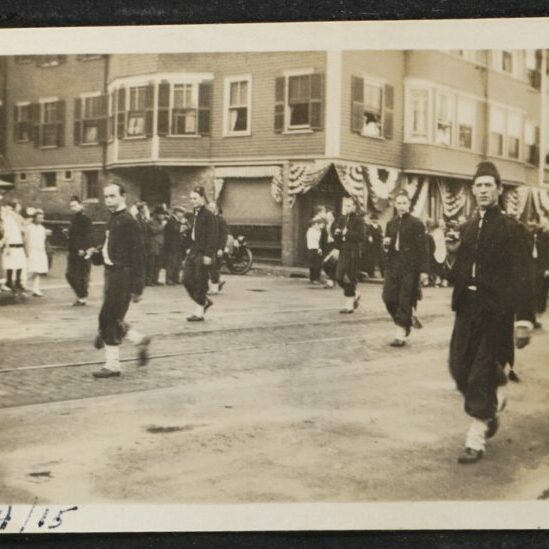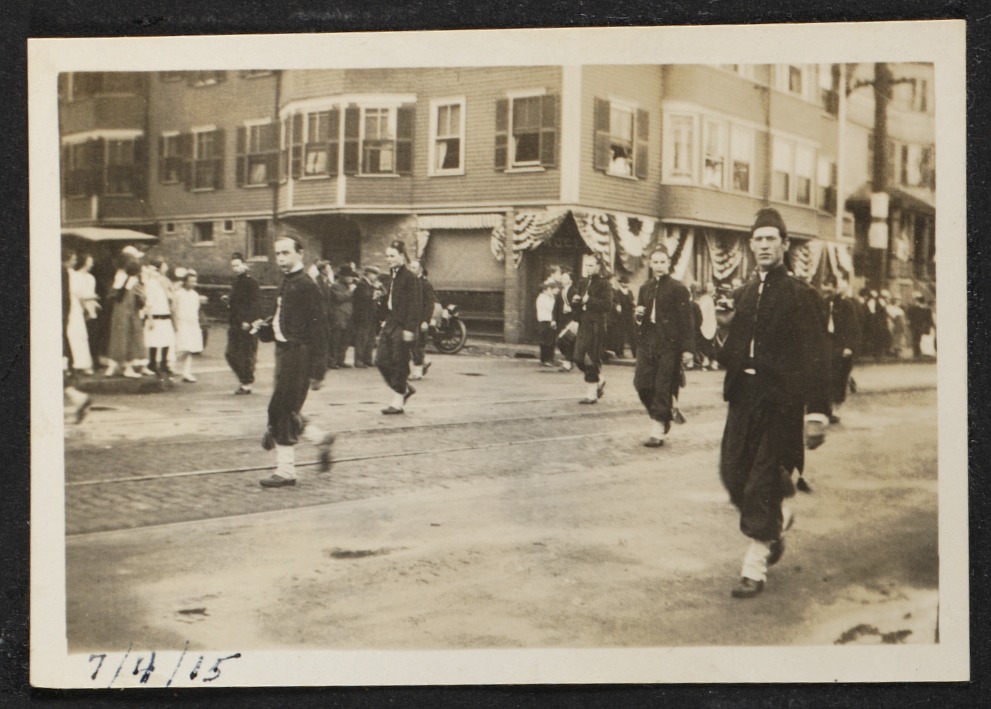
A century ago, the Fourth of July was a chance to meld old and new traditions
By Beth Folsom, 2022
In the early 20th century, the Fourth of July offered concerts, lectures, parades and sporting events to residents of Cambridge and many cities around the country. Whether celebrating in their own neighborhoods with luncheons hosted by local civic or religious groups, playing in or watching a pickup baseball game or track race, or watching the fireworks from the banks of the Charles, Cantabrigians had plenty of options for marking the nation’s birthday. But during the decade between 1910 and 1920, events around the world and across the nation made their way into the city’s Independence Day celebrations, demonstrating how the meaning of the holiday had grown and changed. The holiday is still evolving a century later.
In its July 2, 1910 issue, the Cambridge Chronicle noted that “Cambridge occupies an unique position among the great cities of our country. It is the only city where it is possible to celebrate the 135th anniversary of Washington taking command of the Continental troops on the very spot where this great event occurred,” meaning Cambridge Common. The author went on to hail “that decision made 135 years ago, that meant freedom and liberty, not alone to the men of that day, but to those races of all nations who are coming to our shores at this time.” The demographic profile of new arrivals was changing in the early 20th century, not only in Cambridge but throughout the United States. No longer were immigrants from northern and western Europe making up the majority of newcomers; those from southern and eastern Europe, the Middle East and Asia were increasing in numbers, leading some to fear that the national character was changing – and not for the better.
Public celebrations such as the Fourth of July provided an important opportunity for immigrant communities to join with their local compatriots to declare their loyalty to their new homeland while celebrating the cultures from which they had come. As part of the 1910 Independence Day parade in Cambridge, various ethnic groups organized and took part in the city’s grand parade, marching on foot or on horseback, or riding on floats that represented their national history and culture. This “Pageant of Nations” featured immigrants from Canada, Germany, China, Poland, Portugal, Armenia, and Lithuania; over the course of the next decade, these and other nationalities participated in the city’s Fourth of July parades, celebrating their country of origin and emphasizing their patriotism as assimilated Americans.
This embrace of Independence Day celebrations took on heightened importance at the end of the decade, as the United States entered the First World War. In June 1918, the Chronicle described preparations for the upcoming holiday, noting that “at the request of President Wilson, the states and cities throughout our country will arrange their celebration of the Fourth of July so that the citizens of foreign birth may have an opportunity to demonstrate their loyalty to this country. A short time ago Mayor Quinn received a telegram asking that Cambridge join in such a celebration.” The paper notes that representatives from the Armenian, French Canadian, Greek, Italian, Lithuanian, Portuguese, Polish, Latvian, and Swedish communities gathered at City Hall to plan their respective nationalities’ roles in the celebration, estimating the total participation would be between 5,000 and 7,000 and proclaiming that “the celebration will be one of the biggest demonstrations of the loyalty of our foreign-born citizens that has ever been witnessed in Cambridge.”
The role of the United States in the war also led to the embrace of the Fourth of July in other countries, particularly our allies Great Britain and France. In 1918, King George V publicly marked the anniversary of United States independence in a nod of appreciation to the United States’ assistance in the war effort. And the same year, acting Massachusetts Gov. Calvin Coolidge issued a proclamation calling on cities and towns throughout the commonwealth to fly the French flag in celebration of Bastille Day on July 14, a date that “occupies a similar position in the minds of the people of France that our Fourth of July does with us.” The following year, the Cambridge Sentinel reiterated what it viewed as the unique and lasting ties between the United States and France, declaring that “whatever the manner of its observance in the years to come, the Fourth of July will presumably have much of France in it, now that ties between the nations formed in the Revolution have been strengthened and cemented anew.” Just as the French had come to the aid of the fledgling United States during its war for independence, the United States had provided crucial assistance to France and its allies in the war against Germany.
Although the ways in which Cantabrigians have commemorated the Fourth of July have changed over the past two and a half centuries, taking on meaning and context from contemporary local, national and international events, the holiday has remained one on which a wide variety of Cambridge residents of many ethnicities have been able to combine pride in their national origins with expressions of patriotism to their new homeland. As the demographic diversity of our city continues to grow, Independence Day will doubtless continue to feature this blending of cultural traditions.
This article was originally published in our “Did You Know?” column in Cambridge Day.


